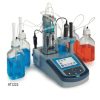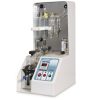TITRALAB AT1000 HACH LANGE:
Reliable results and easy setup.

Tannins are polyphenolic compounds with aromatic rings inside: many OH groups therefore have a strong propensity to capture O2 and consequently a strong antioxidant and antioxidative power.
Among their main characteristics they have the ability to bind to metals (ethyl atom chelation) such as Copper and Iron.
In addition to this, they regulate the oxidation-reduction potential of wine, therefore they can be an alternative to the use of SO2.
Tannins, oxidizing to quinones, produce H2O2: an important intermediate in the formation of ethanal, useful for the formation of stable colored compounds. Tannins-anthocyanins therefore play an important role in stabilizing the color of red wines.
The legislation allows the use of tannins from different botanical origins, from oak, chestnut and grapes.
Alternatives to SO2
So2 in Oenology
Since Sulfur is an allergen, in recent years there has been an increase in the demand for wines produced with increasingly reduced quantities of sulphites. This push from the market has led manufacturing companies and research institutes to seek valid alternatives to its use, with a view to guaranteeing the same or similar protective characteristics.
Control of incoming grapes
The incoming grapes must be healthy: if Botrytis cinerea is present, oxidase enzymes responsible for the oxidation of various grape compounds such as polyphenols, aromatic substances, etc. are released.
SO2 inhibits or destroys the effect of the oxidase enzymes in the must, protecting the musts from fermentative oxidations.
Use of inert gases as protection
One of the most effective methods to reduce the amount of sulfur dioxide is to use inert gases during all processing phases, in order to avoid excessive dissolution of oxygen.
CO2 tends to be used in grapes, while nitrogen or mixtures of inert gases are used in conservation or bottling.
° Thiamine (Vitamin B1)
Vitamin B1 limits the formation of compounds such as pyruvic acid and ketogluconic acid that combine SO2, promotes the growth of yeasts by acting on their metabolism.
The concentration of Thiamine depends on the health condition of the grapes. Healthy grapes contain sufficient doses to protect yeasts from SO2 (0.2 to 0.8 mg/L) while diseased or over-ripe grapes have insufficient concentrations.
Prevent aromas and color
So2 in Oenology
Organoleptic power
If dosed at the right time (at the end of fermentation), SO2 prevents the oxidation of aromas, helping the fruity taste and eliminating moldy and rotten tastes.
If added too early, you may get the opposite result, i.e. unpleasant aromas (rotten eggs).
Due to its ability to bind to precursors and oxidation products, sulfur dioxide can be used as both a preventive and curative treatment.
For example, an oxidized white wine with a brown tint and a nutty odor can be improved by adding sulfur dioxide, which reduces the dark color and binds with acetaldehyde to decrease the perception of its odor.
Clarifying power
SO2 has a clarifying action, as it promotes the coagulation of the colloidal substances present in the must, thus promoting the precipitation of the lees and thanks to the constant antimicrobial action exerted on the bacterial and fungal load of the fermenting must.
Continue reading →Hello world!
Welcome to WordPress. This is your first post. Edit or delete it, then start writing!
Continue reading →






